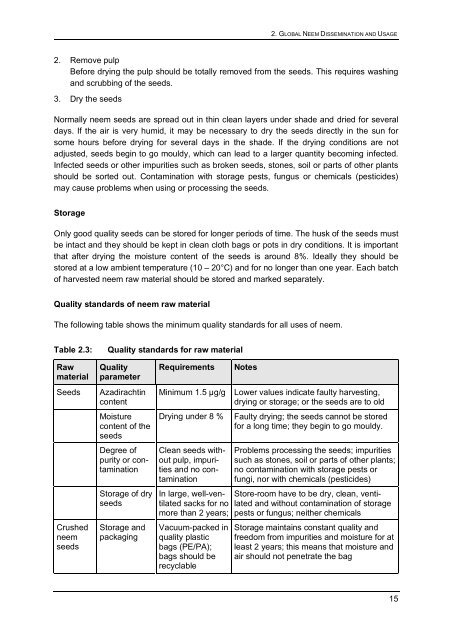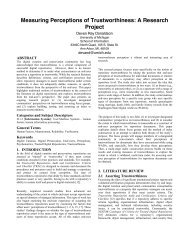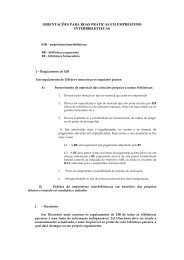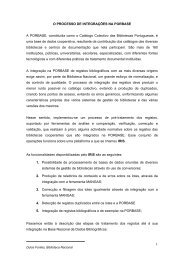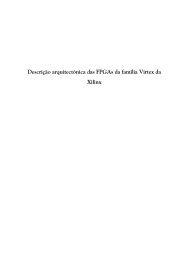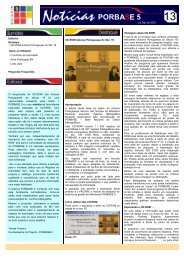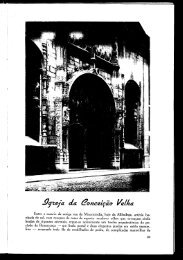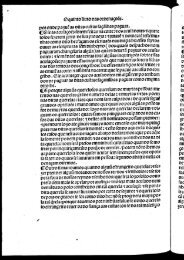Status report on global Neem usage - Biblioteca Nacional de Portugal
Status report on global Neem usage - Biblioteca Nacional de Portugal
Status report on global Neem usage - Biblioteca Nacional de Portugal
You also want an ePaper? Increase the reach of your titles
YUMPU automatically turns print PDFs into web optimized ePapers that Google loves.
2. GLOBAL NEEM DISSEMINATION AND USAGE<br />
2. Remove pulp<br />
Before drying the pulp should be totally removed from the seeds. This requires washing<br />
and scrubbing of the seeds.<br />
3. Dry the seeds<br />
Normally neem seeds are spread out in thin clean layers un<strong>de</strong>r sha<strong>de</strong> and dried for several<br />
days. If the air is very humid, it may be necessary to dry the seeds directly in the sun for<br />
some hours before drying for several days in the sha<strong>de</strong>. If the drying c<strong>on</strong>diti<strong>on</strong>s are not<br />
adjusted, seeds begin to go mouldy, which can lead to a larger quantity becoming infected.<br />
Infected seeds or other impurities such as broken seeds, st<strong>on</strong>es, soil or parts of other plants<br />
should be sorted out. C<strong>on</strong>taminati<strong>on</strong> with storage pests, fungus or chemicals (pestici<strong>de</strong>s)<br />
may cause problems when using or processing the seeds.<br />
Storage<br />
Only good quality seeds can be stored for l<strong>on</strong>ger periods of time. The husk of the seeds must<br />
be intact and they should be kept in clean cloth bags or pots in dry c<strong>on</strong>diti<strong>on</strong>s. It is important<br />
that after drying the moisture c<strong>on</strong>tent of the seeds is around 8%. I<strong>de</strong>ally they should be<br />
stored at a low ambient temperature (10 – 20°C) and for no l<strong>on</strong>ger than <strong>on</strong>e year. Each batch<br />
of harvested neem raw material should be stored and marked separately.<br />
Quality standards of neem raw material<br />
The following table shows the minimum quality standards for all uses of neem.<br />
Table 2.3: Quality standards for raw material<br />
Raw<br />
material<br />
Quality<br />
parameter<br />
Seeds Azadirachtin<br />
c<strong>on</strong>tent<br />
Crushed<br />
neem<br />
seeds<br />
Moisture<br />
c<strong>on</strong>tent of the<br />
seeds<br />
Degree of<br />
purity or c<strong>on</strong>taminati<strong>on</strong><br />
Storage of dry<br />
seeds<br />
Storage and<br />
packaging<br />
Requirements Notes<br />
Minimum 1.5 µg/g Lower values indicate faulty harvesting,<br />
drying or storage; or the seeds are to old<br />
Drying un<strong>de</strong>r 8 % Faulty drying; the seeds cannot be stored<br />
for a l<strong>on</strong>g time; they begin to go mouldy.<br />
Clean seeds without<br />
pulp, impurities<br />
and no c<strong>on</strong>taminati<strong>on</strong><br />
In large, well-ventilated<br />
sacks for no<br />
more than 2 years;<br />
Vacuum-packed in<br />
quality plastic<br />
bags (PE/PA);<br />
bags should be<br />
recyclable<br />
Problems processing the seeds; impurities<br />
such as st<strong>on</strong>es, soil or parts of other plants;<br />
no c<strong>on</strong>taminati<strong>on</strong> with storage pests or<br />
fungi, nor with chemicals (pestici<strong>de</strong>s)<br />
Store-room have to be dry, clean, ventilated<br />
and without c<strong>on</strong>taminati<strong>on</strong> of storage<br />
pests or fungus; neither chemicals<br />
Storage maintains c<strong>on</strong>stant quality and<br />
freedom from impurities and moisture for at<br />
least 2 years; this means that moisture and<br />
air should not penetrate the bag<br />
15


